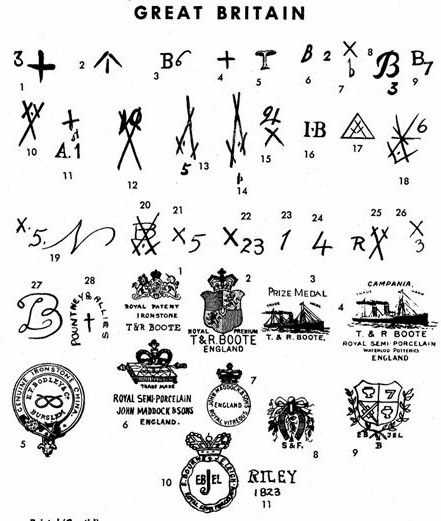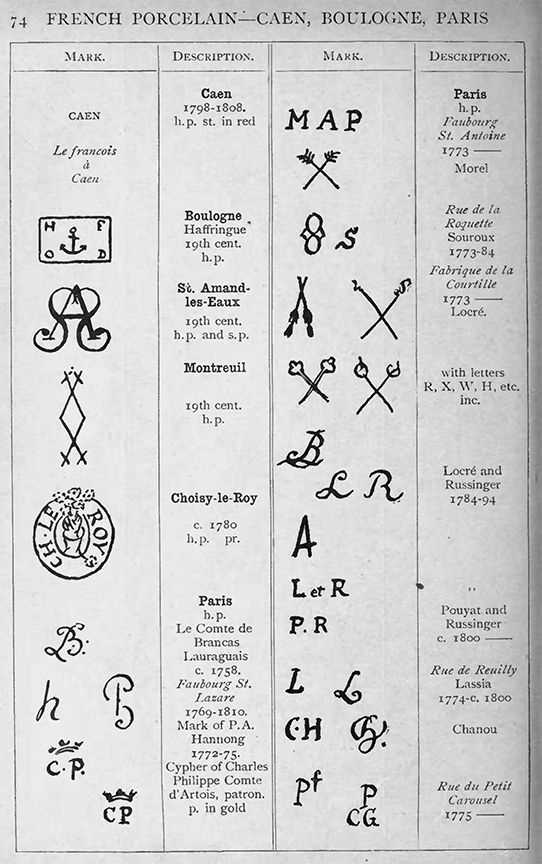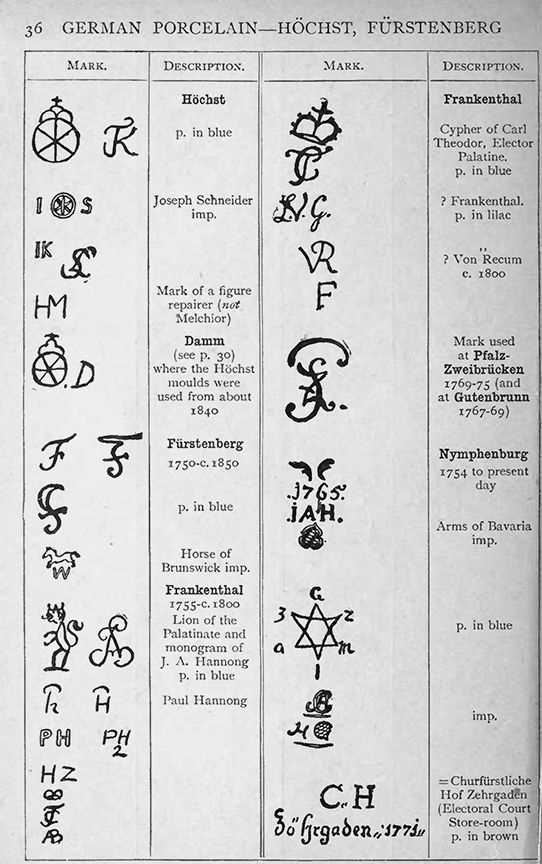French porcelain has a long and rich history, and identifying porcelain marks can be a fascinating journey into the past. Each mark tells a story, revealing the maker, the region, and the period in which the piece was created. Whether you are a seasoned collector or just starting out, this guide will provide you with the essential tips and techniques to identify French porcelain marks.
One of the first things to look for when identifying French porcelain marks is the signature or mark of the maker. These marks usually consist of initials or a symbol that represents the maker or factory. Some famous porcelain makers in France include Sèvres, Limoges, and Chantilly. Learning about the different marks used by these manufacturers can help you attribute the piece to the correct maker and determine its value.
Another important clue to look for is the region where the porcelain was made. Different regions in France had their own distinct styles and techniques, and this is reflected in the marks found on the porcelain. For example, porcelain from Sèvres often has a crossed L’s mark, while Limoges porcelain is typically marked with a T&V or a lantern symbol. By familiarizing yourself with these regional marks, you can gain insight into the origins of the piece.
Lastly, the period in which the porcelain was produced can also be determined by the mark. Most French porcelain marks include a date code or a series of symbols that indicate the year of production. These date codes can range from a single letter to a combination of letters and numbers. Researching these date codes and studying the evolution of the marks over time can be a valuable tool in dating and authenticating French porcelain.
Tip: When researching French porcelain marks, consult reference books, online databases, and specialized forums. Joining a community of collectors and experts can provide valuable insights and guidance in identifying and valuing French porcelain.
French Porcelain Marks Overview
French porcelain marks can provide valuable information about the origin, age, and quality of a piece. These marks are typically stamped or painted on the bottom of the porcelain item and can vary in style and design.
1. Stamps versus hand-painted marks:
- French porcelain marks can be either stamped or hand-painted.
- Stamped marks are usually more common and consistent, while hand-painted marks can vary in style and quality.
2. Factory and manufacturer marks:
- Many French porcelain marks indicate the factory or manufacturer that produced the piece.
- These marks can range from simple initials or symbols to more elaborate logos or emblems.
3. Date marks:
- Some French porcelain marks include date codes that indicate the year the piece was made.
- These date codes can take the form of letters, numbers, or symbols.
4. Quality and authenticity marks:
- French porcelain marks can also indicate the quality or authenticity of a piece.
- For example, the presence of a certain mark may indicate that the piece was made according to strict quality standards or that it is a limited edition.
5. Regional marks:
- Certain French porcelain marks are specific to a particular region or area of production.
- These regional marks can provide insight into the history and origin of the piece.
Overall, French porcelain marks can be a helpful tool in identifying and evaluating pieces of porcelain. By understanding the different types of marks and their meanings, collectors and enthusiasts can gain a deeper appreciation for the artistry and craftsmanship of French porcelain.
Importance of Identifying French Porcelain Marks
Identifying French porcelain marks is essential for collectors, antique dealers, and enthusiasts who want to determine the origin, age, and value of their pieces. French porcelain has a long and rich history, and the markings on these pieces can provide valuable clues about their authenticity, craftsmanship, and historical significance.
1. Authentication: French porcelain marks serve as a crucial tool for authenticating pieces. By comparing the marks on a piece with known patterns and styles from different eras, experts can determine if it is a genuine piece from a specific porcelain factory and time period.
2. Dating and Provenance: Porcelain marks often include specific symbols, letters, or monograms that can help identify the manufacturer, artist, or decorator. By researching these marks, collectors can establish the age and provenance of their pieces, providing valuable historical context.
3. Value Assessment: The identification of French porcelain marks can significantly impact the value of a piece. Certain marks are associated with renowned factories or artists, making them highly sought-after by collectors. On the other hand, lesser-known marks or reproductions may indicate a lower value.
4. Rarity and Uniqueness: Some French porcelain marks represent rare or unique patterns, designs, or techniques that are highly prized by collectors. Identifying these marks allows enthusiasts to appreciate the rarity and uniqueness of their pieces, making them even more special.
|
In conclusion, identifying French porcelain marks is of utmost importance for collectors, antique dealers, and enthusiasts. It helps with authentication, dating, provenance, value assessment, and appreciation of these beautiful and historical pieces. By delving into the world of porcelain marks, individuals can deepen their understanding of French porcelain and its place in art history.
Researching French Porcelain Manufacturers
When it comes to identifying French porcelain marks, it is essential to have some knowledge about the different manufacturers who produced these pieces. Researching French porcelain manufacturers can help you determine the origin and age of a particular piece, which can be valuable information for collectors and enthusiasts.
Here are some tips and techniques to help you in your research:
- Consult reference books: There are several reference books available that provide information on French porcelain manufacturers and their marks. These books often include detailed descriptions of the marks and the history of the manufacturers. Some popular reference books include “French Porcelain: A Catalogue of the British Museum Collection” by Frank Britton and “Marks on French Faïence and Porcelain” by Régine de Plinval de Guillebon.
- Visit museums: Museums often have collections of French porcelain that can be used for research purposes. Visiting these museums can give you the opportunity to examine pieces up close and learn about the different manufacturers and their marks. The Musée national de la Porcelaine Adrien-Dubouché in Limoges, France, is an excellent example of a museum dedicated to French porcelain.
- Join online forums: Online forums and discussion boards are a valuable resource for collectors and researchers. Joining these communities can help you connect with other enthusiasts who may have knowledge and expertise in French porcelain. These forums often have dedicated sections for discussing marks and manufacturers, where you can ask questions and share information.
- Explore online databases: There are several online databases that can be used to search for information on French porcelain manufacturers and their marks. These databases often include images of marks and details about the manufacturers. Websites like “Porcelain Marks & More” and “Gotheborg.com” are popular resources for researching porcelain marks.
- Examine the piece: Carefully examine the porcelain piece itself for any clues about the manufacturer. Look for marks or signatures on the bottom or back of the piece, as well as any other identifying features. Note down any details and compare them to known marks and manufacturers. This process of comparison can help you narrow down the possibilities.
Remember that researching French porcelain manufacturers can be a time-consuming process, but the results can be rewarding. By acquiring knowledge about different manufacturers and their marks, you can become more confident in your ability to identify and authenticate French porcelain pieces.
Decoding French Porcelain Markings
French porcelain markings can provide valuable information about the origins and history of a piece. Decoding these markings requires some knowledge of French porcelain factories and their corresponding marks. Here are some tips and techniques to help you decipher French porcelain markings:
- Pay attention to the shape and style of the mark: French porcelain marks vary in shape and style depending on the time period and the factory. Familiarize yourself with the different shapes and styles used by the major French porcelain factories, such as Sevres, Limoges, and Minton.
- Look for initials or symbols: Many French porcelain marks feature initials or symbols that represent the factory or the artist. For example, the Sevres factory often used a double L monogram or the initials “SG” for Sèvres, while Limoges marks often feature a crowned Limoges shield.
- Check for date codes: Some French porcelain marks include date codes that can help narrow down the time period of the piece. These date codes may be in the form of letters, numbers, or symbols, and they can often be found near the factory mark or on the bottom of the piece.
- Research the factory: Each French porcelain factory has its own unique history and production techniques, which can help you identify the origin of a piece. Consult reference books, online resources, or visit a museum or antique shop specializing in French porcelain to learn more about specific factories and their marks.
- Consider the overall quality and style of the piece: French porcelain marks can provide a general indication of the piece’s origin, but it’s important to also take into account the overall quality and style. Look for characteristics such as the type of decoration, the shape of the piece, and the quality of the materials used. These factors can help confirm or further narrow down the identification of a piece.
Decoding French porcelain markings can be a challenging but rewarding task. By familiarizing yourself with the different marks and factories, conducting research, and considering the overall characteristics of the piece, you can gain a better understanding of its origins and history.
Key Features to Look Out For
When identifying French porcelain marks, there are several key features to look out for. These features can help you determine the age, origin, and authenticity of the piece.
- Maker’s Mark: The maker’s mark or stamp is one of the most important features to look for. It is usually a symbol, initials, or a combination of both that identifies the manufacturer.
- Pattern: The pattern on the porcelain can provide important clues about its origin. French porcelain often features intricate designs such as floral motifs, landscapes, or scenes from mythology.
- Marking Style: Pay attention to the style of the mark. Different styles were used during different periods, so this can help you determine the age of the piece. For example, marks from the 18th century may be more elaborate and ornate, while marks from the 19th century may be simpler and more refined.
- Location of Mark: The location of the mark can also provide useful information. Some French porcelain marks are located on the bottom of the piece, while others may be found on the side, near the handle, or even inside the item.
- Additional Markings: Look out for any additional markings such as numbers, letters, or symbols. These markings may indicate the year of production, the specific artist or decorator, or other important details.
- Quality of Porcelain: Examine the overall quality of the porcelain. French porcelain is known for its fine craftsmanship and attention to detail. Look for smooth finishes, crisp edges, and vibrant colors.
By paying attention to these key features, you can become more confident in identifying French porcelain marks and gaining a better understanding of the pieces you encounter.
Common French Porcelain Markings
When identifying French porcelain, it can be helpful to understand the common markings used by manufacturers. These markings can give you clues about the origin, age, and quality of the piece. Here are some of the most common French porcelain markings:
- Sevres: Sevres is one of the most famous French porcelain manufacturers. Their markings usually include the word “Sevres” along with a date mark, which indicates the year the piece was made. The markings may also feature a monogram or a crown symbol.
- Limoges: Limoges is another well-known French porcelain manufacturer. Their markings often feature the word “Limoges” along with a symbol or monogram. The mark may also include the words “France” or “Made in France.”
- Chantilly: Chantilly is an old French porcelain manufacturer that produced pieces in the 18th century. Their markings often include a monogram or symbol, such as a fleur-de-lis or a bird.
These are just a few examples of common French porcelain markings. It’s important to note that markings can vary, and some pieces may not have any markings at all. Additionally, some manufacturers may have used multiple markings throughout their history, so it’s helpful to consult a reference guide or expert for more specific identification.
If you come across a piece of French porcelain with an unfamiliar marking, you can also try researching the marking online or reaching out to a porcelain collector or dealer for assistance. With some time and research, you can become more proficient at identifying French porcelain markings and gain a better understanding of the history and value of your pieces.
Seeking Expert Advice
If you are having difficulty identifying a French porcelain mark, it may be helpful to seek expert advice. There are several resources available to assist you in your research:
- Antique Dealers: Reach out to local antique dealers who specialize in French porcelain. They often have extensive knowledge and experience in identifying marks and can provide guidance.
- Porcelain Collectors’ Forums: Online forums dedicated to porcelain collecting can be valuable resources. Post clear images of the mark and any accompanying details, and fellow collectors may be able to offer insights and suggestions.
- Porcelain Books and Guides: Invest in a good reference book or guide that specializes in French porcelain marks. These resources often include detailed illustrations and explanations of various marks and can be an invaluable tool in the identification process.
- Porcelain Experts and Appraisers: When in doubt, consult a professional. There are experts and appraisers who specialize in French porcelain and can provide expert advice and authentication services.
Remember to provide as much information as possible when seeking expert advice. Include clear images of the mark, any accompanying symbols or letters, and any other relevant details, such as the age or style of the piece. The more information you can provide, the better chance you have of receiving accurate and helpful guidance. Good luck in your pursuit of identifying French porcelain marks!
Tips for Authenticating French Porcelain
When it comes to identifying and authenticating French porcelain, it’s important to pay attention to the markings and characteristics of each piece. Here are some tips to help you authenticate French porcelain:
- Research: Familiarize yourself with the different French porcelain manufacturers and their marks. This will help you identify and authenticate pieces more easily.
- Inspect the mark: Look for the manufacturer’s mark on the bottom of the piece. French porcelain marks often include the manufacturer’s name or initials, a symbol or a combination of both. Compare the mark with known manufacturer marks to determine its authenticity.
- Study the style: French porcelain manufacturers often have distinct styles and patterns. Study the style of the piece, including the shape, design, and color. Compare it with known examples of the manufacturer’s work to authenticate it.
- Check for quality: French porcelain is known for its high-quality craftsmanship. Look for fine details, smooth finishes, and delicate painting. Poor quality or sloppy craftsmanship may indicate a reproduction or imitation.
- Consult experts: If you’re unsure about the authenticity of a piece, consult with experts or appraisers who specialize in French porcelain. They can provide valuable insights and help you make a more informed decision.
Remember, authenticating French porcelain is a skill that develops with experience and research. It’s important to take your time, gather information, and carefully examine each piece to make an accurate assessment of its authenticity.
FAQ:
What is the importance of identifying French porcelain marks?
Identifying French porcelain marks is important because it helps determine the authenticity and age of a piece. It can also provide information about the manufacturer and the specific period in which the piece was produced.
How can I identify French porcelain marks?
To identify French porcelain marks, you can start by researching different manufacturers and the marks they used. You can also consult reference books and online databases that provide information and images of different marks. Additionally, examining the style, quality, and materials used in the piece can also help in identification.
Are there any specific tips or techniques for identifying French porcelain marks?
Yes, there are several tips and techniques that can be helpful in identifying French porcelain marks. These include understanding different types of marks such as factory marks, artist signatures, and pattern marks. It is also important to look for clues like the style and design of the piece, as well as any additional markings or numbers that may be present.
Are there any common French porcelain marks that I should be aware of?
Yes, there are several common French porcelain marks that collectors should be aware of. Some examples include the Sevres mark, which was used by the Royal Porcelain Factory in Sevres, and the Limoges mark, which indicates that the piece was made in the Limoges region. Other common marks include those associated with specific manufacturers such as Wedgwood, Meissen, and Minton.


